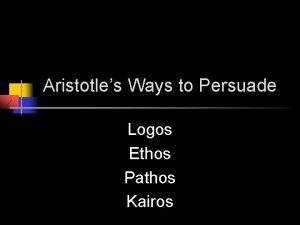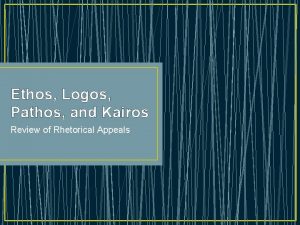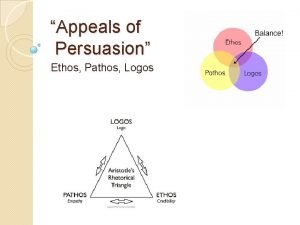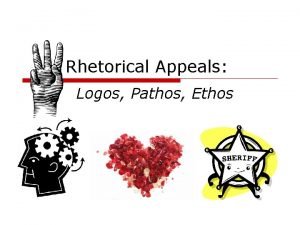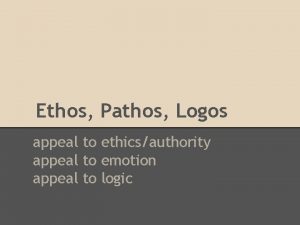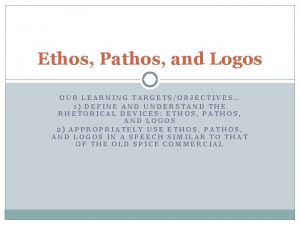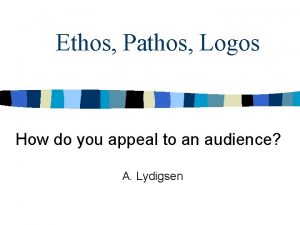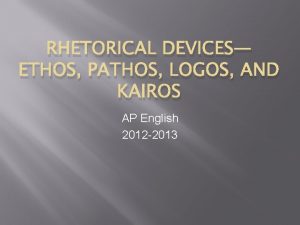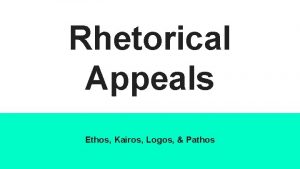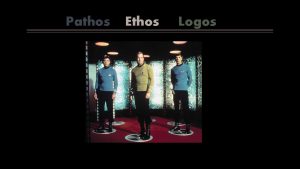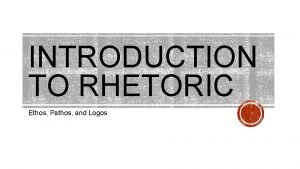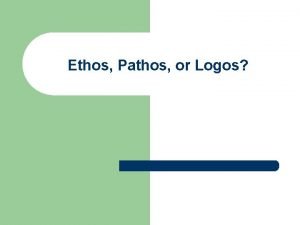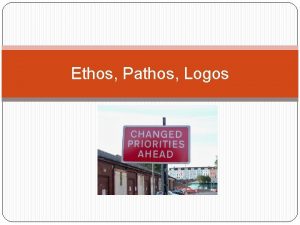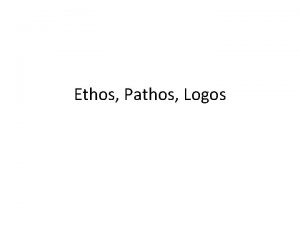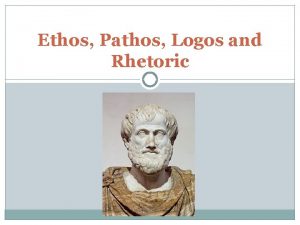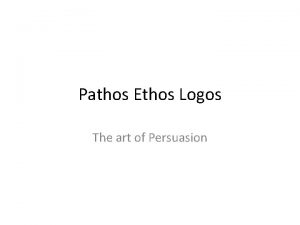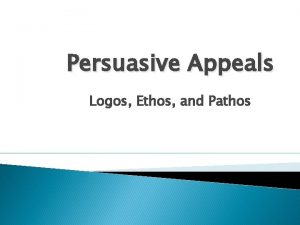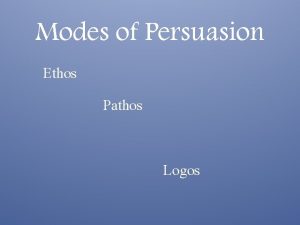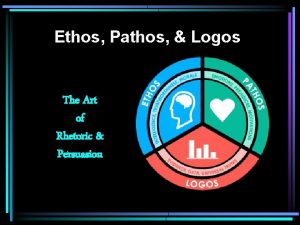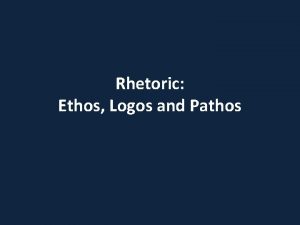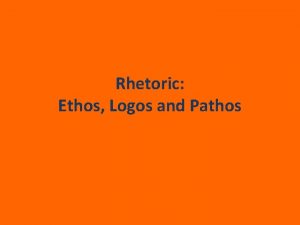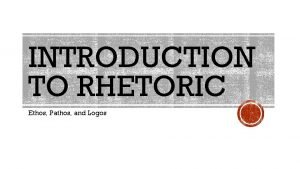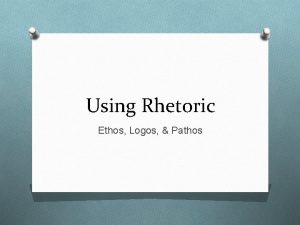PERSUASION AND RHETORIC Using Ethos Pathos and Logos


















- Slides: 18

PERSUASION AND RHETORIC Using Ethos, Pathos and Logos

What is Rhetoric? Rhetoric (n) - the art of speaking or writing effectively (Webster's Definition). • According to Aristotle, rhetoric is "the ability, in each particular case, to see the available means of persuasion. "

Rhetorical Triangle Aristotle believed that from the world around them, speakers could observe how communication happens and use that understanding to develop sound and convincing arguments. In order to do that, speakers needed to look at three elements, graphically represented by what we now call the rhetorical triangle: Subject, Audience, Speaker’s Persona Speaker Audience Subject

Rhetoric Aristotle said that when a rhetor or speaker begins to consider how to compose a speech— that is, begins the process of invention—the speaker must take into account the three elements; hence, the triangle. Considering the subject means writer/speaker evaluates what he or she knows already and needs to know, investigates perspectives, and determines kinds of evidence or proofs (evidence) that seem most useful. Considering the audience means speculating about the reader’s expectations, knowledge, and disposition with regard to the subject writers explore. Writers (Speakers) use who they are, what they know and feel, and what they’ve seen and done to find their attitudes toward a subject and their understanding of the reader. The creation of that voice Aristotle called the persona, the character the speaker creates as he or she writes.

ARISTOTLE’S RHETORICAL CHART Author’s Purpose Logos Ethos Pathos The core of the rhetorical chart is purpose—What does the author/speaker cartoonist/filmmaker/advertiser want the reader/listener/viewer to Feel? Think? Do?

THE THREE APPEALS Aristotle described three main forms of rhetoric. We use these to influence the audience and persuade them to understand our argument. • ETHOS • PATHOS • LOGOS

ETHOS Ethos: Ethics To make the audience decide right or wrong about what is being presented to it Political issues, national beliefs, religious issues, etc… Typically has contrasting colors or objects symbolizing the difference between good and evil. This places the CHOICE on our Consciences

PATHOS Pathos: Emotion To make the audience feel something about what is presented to it Children, animals, illness, memories, etc… “Tugs at your heart strings” If we feel, then we will ACT…no matter the emotion.

LOGOS Logos: Logic To make the audience think about what is presented to it Statistics, facts, authorities, etc… Very straightforward, and not “fluff”. It has a very scientific, factual approach. In short, it asks the following questions: • Why does it make sense to do this? • Is it logical or beneficial to do this?

ETHOS, PATHOS OR LOGOS?

ETHOS, PATHOS OR LOGOS?

ETHOS, PATHOS OR LOGOS?

ETHOS, PATHOS OR LOGOS?

PERSUASIVE WRITING The goal of argumentative/persuasive writing is to inform your audience that your ideas are valid, or more valid than someone else's.

PERSUASIVE WRITING Questions for considering a writer’s Ethos: • Does he or she seem knowledgeable? Reasonable? Trustworthy? • Does he or she treat their opponents with fairness and respect or do they take cheap shots? • Does he or she try and establish common ground with the reader/audience?

PERSUASIVE WRITING Questions for considering a writer’s Pathos: • Does the topic matter to the audience? • Does the writer include anecdotes? • Does the writer appeal to your emotions, memories, fears, etc. ? • Is the emotional appeal effective or overwhelming? • Is the writing overloaded with facts and figures?

PERSUASIVE WRITING Questions for considering a text’s Logos: • What is being argued or what is the author’s thesis? • What points does the author offer to support their thesis? • Are ideas presented logically?

AD ANALYSIS Your homework is to bring in to class a print advertisement (school appropriate…when in doubt don’t do it). It MUST be an ad with both image and TEXT!!!!! Leave your ad on your desk. You and one other person will analyze 10 ads. Complete the following for each: • The # & Name of “product” being advertised A: Intended Audience B: Spoken person (if there is one) C: Purpose of advertisement D: Type of persuasive appeals-briefly explain
 Logos pathos ethos kairos examples
Logos pathos ethos kairos examples Ethos pathos logos
Ethos pathos logos Logos ethos pathos and kairos
Logos ethos pathos and kairos Ethos pathos logos
Ethos pathos logos What greek philosopher named the appeals ethos pathos logos
What greek philosopher named the appeals ethos pathos logos Ethos
Ethos Define ethos pathos and logos
Define ethos pathos and logos Kairos pathos logos ethos
Kairos pathos logos ethos Def of logos pathos and ethos
Def of logos pathos and ethos Rhetorical device logos?
Rhetorical device logos? Pathos ethos logos examples
Pathos ethos logos examples Ethos pathos logos and kairos
Ethos pathos logos and kairos Logos ethos pathos triangle
Logos ethos pathos triangle Ethos pathos logos triangle
Ethos pathos logos triangle Repetition rhetorical devices
Repetition rhetorical devices Pathos ethos logos kairos
Pathos ethos logos kairos Ethos authority
Ethos authority Logos rhetoric definition
Logos rhetoric definition Appeals ethos pathos logos
Appeals ethos pathos logos
